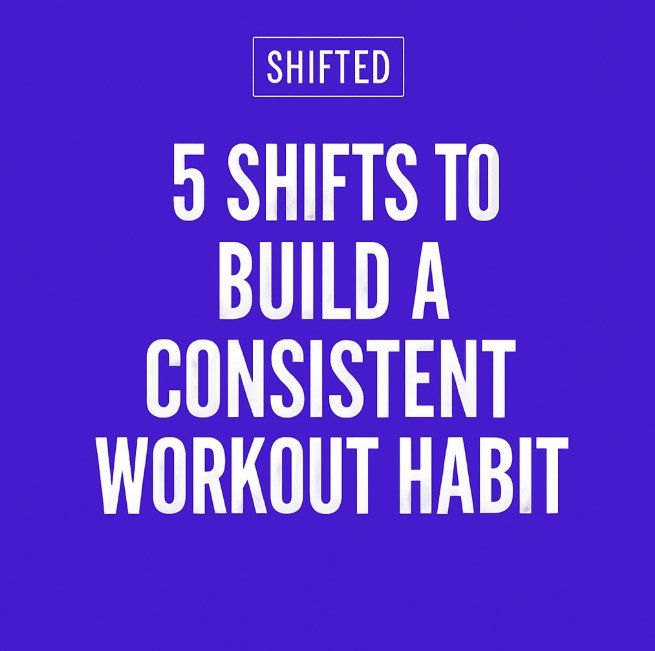5 Shifts
5 Shifts to Build a Consistent Workout Habit

Starting a workout routine is not the hardest part for most people. The real challenge is staying consistent over time. Many people begin exercising with excitement but struggle to maintain the habit after a few weeks. Life gets busy, motivation fades, or workouts start feeling like a chore. The good news is that building a long-term workout habit is possible with a few simple shifts in your mindset and daily routine. These five shifts can help you create a workout habit that sticks.
Shift 1: Focus on Small, Achievable Goals

One of the most common reasons people quit exercising is setting goals that are too big or unrealistic. When you aim for huge results too quickly, it’s easy to feel overwhelmed or discouraged if progress is slow. Instead, start with small, achievable goals that fit your current fitness level and schedule.
For example:
- Begin with 10-15 minutes of activity a day.
- Aim for three short workouts a week instead of daily intense sessions.
- Focus on consistency rather than perfection.
Small wins build confidence and create a positive habit loop. As you succeed with small goals, you can gradually increase the time, intensity, or frequency of your workouts. The key is to make exercise feel manageable and rewarding from the start.
Shift 2: Make Workouts Part of Your Daily Routine

Habits form more easily when they are tied to your daily routine. If you have to decide each day whether or not you will exercise, you are more likely to skip it when life gets busy. Instead, schedule your workouts like appointments that you don’t miss.
Here are some ways to add workouts to your routine:
- Exercise at the same time each day, such as right after waking up or during your lunch break.
- Pair your workout with an existing habit, like stretching after brushing your teeth.
- Use reminders or calendar alerts to keep workouts on your schedule.
When workouts become part of your normal day, they require less mental effort and decision-making. Over time, they feel as automatic as brushing your teeth or drinking your morning coffee.
Shift 3: Choose Activities You Enjoy

It’s difficult to stick with a workout habit if you dread the activity itself. Many people quit exercising because they force themselves to do workouts they don’t like, thinking it’s the only way to get results. In reality, you’re much more likely to stay consistent if you choose forms of exercise you enjoy.
Consider trying different activities such as:
- Walking or hiking
- Swimming
- Cycling
- Dancing
- Group fitness classes
- Yoga or Pilates
- Playing a sport
- Home workout videos or apps
There’s no one “best” workout for everyone. The best workout for you is the one you enjoy and can do regularly. You don’t need to follow a strict gym routine if other activities keep you moving and motivated.
Shift 4: Track Your Progress and Celebrate Small Wins

Seeing progress can motivate you to keep going, even when your main fitness goals feel far away. Tracking your workouts helps you stay aware of your consistency and improvements over time.
- Ways to track your progress include:
- Marking workout days on a calendar
- Using fitness apps or wearable devices
- Keeping a simple workout log
- Taking progress photos every few weeks
- Tracking strength or endurance improvements
Along with tracking, take time to celebrate your small wins. Completing a full week of workouts, running a little farther, or lifting slightly more weight are all achievements worth recognizing. Positive reinforcement helps strengthen your commitment to your workout habit.
Shift 5: Prepare for Obstacles in Advance

No matter how motivated you feel when you start, there will be times when life gets in the way. Illness, work stress, family responsibilities, or travel can interrupt your routine. Planning for these obstacles in advance helps you stay flexible rather than giving up entirely.
Some tips to stay on track when challenges arise:
- Have backup workouts you can do at home or while traveling.
- Accept that it’s okay to take rest days when needed, but commit to starting again as soon as possible.
- Avoid the “all-or-nothing” mindset. A short workout is better than none.
- Remind yourself why you started and how good you feel after exercising.
Consistency does not mean being perfect. It means returning to your routine even after small setbacks. By preparing mentally for obstacles, you can handle them without losing your momentum.
Additional Tips for Long-Term Workout Success
Along with the five main shifts, here are a few extra tips that can help you build a strong and lasting workout habit:
- Set clear but flexible goals that you can adjust as needed.
- Find a workout buddy for added motivation and accountability.
- Keep your workout gear easily accessible to reduce excuses.
- Mix up your workouts to avoid boredom and keep things interesting.
- Focus on how exercise makes you feel rather than only chasing physical results.
When to Seek Professional Help
If you’re unsure how to start or feel overwhelmed, consider consulting a fitness professional. A personal trainer, physical therapist, or certified coach can help you create a safe and effective workout plan based on your current fitness level, goals, and any health concerns. They can also teach you proper form to avoid injury and build confidence.
Final Thoughts
Building a consistent workout habit doesn’t require extreme effort or perfect discipline. By making a few simple shifts in your approach, you can create a routine that fits your life and keeps you motivated for the long run. Start with small, manageable goals, schedule your workouts into your day, choose activities you enjoy, track your progress, and plan for obstacles. These steady shifts can turn exercise from a chore into a regular part of your lifestyle, leading to better health, more energy, and greater well-being.
-

 Social Media2 months ago
Social Media2 months agoWhat the “67” TikTok Meme Really Means
-

 Tech2 months ago
Tech2 months agoWhat To Do When Your Business Faces Network Vulnerabilities
-

 Self Improvement2 months ago
Self Improvement2 months agoUsing BCBS Rehab to Access Quality Addiction Care
-

 Games2 months ago
Games2 months agoPusoy Strategies for Play That Also Work in Pusoy Dos in English






